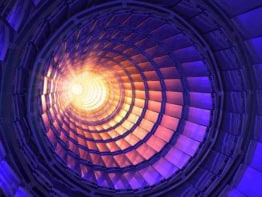
A new experiment to search for hypothetical particles known as sterile neutrinos has been given the green light by scientists at the CERN particle-physics laboratory near Geneva. The SFr 200m (£140m) Search for Hidden Particles experiment (SHiP) would be built at CERN and start up a decade from now. The lab’s member states will, however, need to approve the project before construction.
Predicted by certain extensions of the Standard Model, sterile neutrinos – if they exist – would interact extremely weakly, if at all, with ordinary matter. However, sterile neutrinos would transform into and out of standard neutrinos, revealing themselves via a greater- or lesser-than-expected rate of oscillation between the different types, or “flavours”, of neutrinos. Physicists working on the Liquid Scintillator Neutrino Detector (LSND) at the Los Alamos National Laboratory in New Mexico between 1993 and 1998 saw some evidence for such a transformation, but other experiments have failed to see a similar signal.
There are other plans to look for these hypothetical particles, but these experiments would focus on light sterile neutrinos with masses of less than one electronvolt. SHiP, in contrast, would seek more massive sterile neutrinos known as heavy neutral leptons. Weighing a few gigaelectronvolts, such particles would, very occasionally, decay into ordinary matter. According to SHiP spokesman Andrey Golutvin of CERN, their existence, unlike that of their lighter counterparts, could explain the predominance of matter over antimatter in the universe and the nature of dark matter. “Finding a light sterile neutrino would be a Nobel prize discovery, but it wouldn’t solve the problems of the Standard Model,” he claims.
Specific signature
SHiP would involve building a new target and detector to exploit the high-intensity proton beam produced by CERN’s Super Proton Synchrotron (SPS). Incoming protons would strike a tungsten-molybdenum target, generating mesons containing charm quarks that would decay to produce standard neutrinos, which might, in turn, oscillate into heavy sterile neutrinos. After passing through a magnetic shield to deflect muons and other unwanted particles generated in the target, the sterile neutrinos would then enter a 50 m-long vacuum chamber. If they decay, they would leave a specific signature: two oppositely charged tracks emerging from a vertex, plus a well-defined mass for the decaying particle.
The SHiP design was endorsed by CERN’s SPS and PS experiments Committee (SPSC) at a meeting held on 19 and 20 January. The committee said it was “impressed” by the collaboration’s response to earlier requests to modify the experiment’s design and schedule, and recommended that the group now prepare a comprehensive design report. Golutvin says that this report, which will require testing detector prototypes, should be ready in time for the EU’s next strategic review of particle physics in 2019. If the experiment is approved by CERN Council, he says it should start taking data when the Large Hadron Collider (LHC) emerges from its third long shutdown in 2026.
Complementary approach
William Louis, a physicist at Los Alamos who worked on the LSND, says that it is important to have a “wide variety” of sterile-neutrino experiments to “probe different mass scales”. He believes that SHiP would complement experiments in the US and Japan that are also studying heavy sterile neutrinos. Patrick Huber of Virginia Tech in the US points out that scientists have very little idea about the mass of hypothetical sterile neutrinos and, by searching for these and other particles over previously unchartered masses and interaction strengths, he believes SHiP will provide “a very nice complementary approach to the LHC”.
However, Luca Stanco of Italy’s National Institute of Nuclear Physics in Padua argues that SHiP will probe a relatively small region of “parameter space” that does not justify the experiment’s considerable price tag. He says that the idea of a heavy sterile neutrino is “intriguing and appeals to many theoreticians”, but adds wryly that “theoreticians were pretty much sure about supersymmetry too”.



